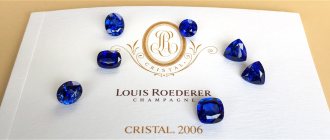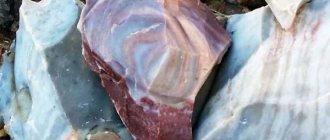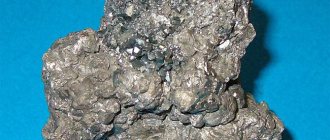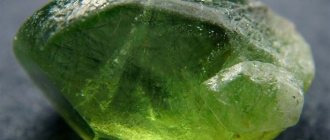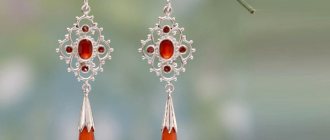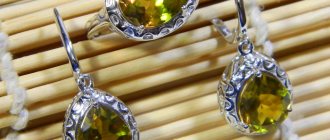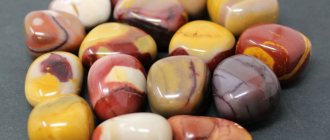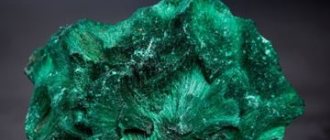Not every lady can afford luxurious jewelry with natural stones. And everyone wants to buy something beautiful. For these purposes, scientists have developed artificial stones from natural substances. Using nanotechnology, a glass ceramic crystal was created. In terms of its appearance, it is not inferior to many natural stones. Today, glass ceramics are produced in various colors.
Origin story
A mineral called glass-ceramic is considered to be an absolutely man-made work of man. The material is not considered natural; it is obtained synthetically. It is a crystalline glass material with properties somewhat similar to aluminosilicate glass.
It is impossible to say unambiguously who first created the material; today the rights of the “creators” are disputed by the United States and Russia. The fact is that in 1957, the cultivation technology was created by D. Stuckey, an American. The product was called pyroceram.
In the USSR, I. I. Kitaigorodsky, at about the same time, proposed not to dispose of blast furnace slag (metallurgical waste), but to use it as a raw material for creating a new synthetic rock. Soviet scientists named the gem glass-ceramic, associating the name with “glass, crystals” or maybe with “aluminum and sicilium”; this is also not clear to everyone.
Note! The synthetic product is considered an analogue of obsidian volcanic glass.
Types of glass ceramics in jewelry
In jewelry, glass ceramics of different sizes, colors and cuts are used. With these inserts they create brooches and rings, pendants and bracelets, necklaces and earrings. Let us remind you that the color palette of crystals is practically unlimited, but the most popular are:
- glass-ceramic topaz. Nanostalls are similar to topaz, and this feature is often used by jewelers. In particular, glass-ceramics are used to replace London-colored topazes - this is a very beautiful and valuable stone, its natural reserves will soon be exhausted. Jewelry with glass-ceramic topaz is in high demand, because the stones are practically indistinguishable in appearance, but their prices are very different;
- Sitall-tourmaline. In particular, rare Paraiba tourmalines are replaced with the help of sitalls: the age of these stones reaches several billion years. Sitalls-tourmalines are externally indistinguishable from natural stones; they are the same delicate turquoise color and the light plays beautifully in them, while the crystals are hard and resistant to damage;
- Sitall-amethrine. A substitute for ametrine - a two-color amethyst, very rare and expensive. Externally, it is difficult to distinguish a natural stone from a synthetic one, and for a non-specialist it is impossible;
- Sitall-morganite. An artificial analogue of the rare stone morganite (the second name of the mineral is sparrowite). Natural morganite is rare and very beautiful: it has a soft pink color, which is due to the composition of the mineral - a mixture of beryl and manganese. The price of morganite is high due to its rarity, and the artificial substitute is about 20 times cheaper.
Sitalls are excellent substitutes for natural stones. A layman is unlikely to be able to distinguish an artificial crystal from a real topaz or tourmaline: it is almost impossible to do this with the naked eye and without special knowledge.
The resemblance to natural stones is a significant plus, because substitutes are much cheaper and it is more profitable to buy several jewelry with glass ceramics than one with a natural mineral. But there is another side to the coin - scammers take advantage of this similarity, so carefully check the documents for the stone if you want to buy a natural mineral.
Colors and varieties
The unique technology for creating new generation nanocrystals allows you to obtain completely different shades. The sizes of stones and shapes can be absolutely any. The degree of transparency of artificially produced nuggets can also be absolutely any.
Based on this, the following varieties of glass ceramics are obtained:
- jewelry;
- ceramic;
- slag ceramics.
The product differs in properties, features of use, accordingly, cost and demand. By setting the desired color parameters, scientists produce the following properties:
- London Sitall;
- Madeira citrine;
- garnet trillion;
- paraiba tourmaline;
- ametrine;
- tanzanite;
- sultanite
Any jewelry nanocrystal will be many times purer and more transparent than a natural sample.
Magical or not?
Sitalls are grown by humans, so they have no healing or magical properties.
But there are advantages to this. Intrigues or “whims” on the part of the stone are excluded. The most powerful sorcerers or other ill-wishers cannot charge it to the detriment of the owner.
Finally, you can choose and wear jewelry as you wish: sital suits everyone, regardless of their zodiac sign.
| Zodiac sign | Compatibility |
| Aries | + |
| Taurus | + |
| Twins | + |
| Cancer | + |
| a lion | + |
| Virgo | + |
| Scales | + |
| Scorpion | + |
| Sagittarius | + |
| Capricorn | + |
| Aquarius | + |
| Fish | + |
(“+++” – fits perfectly, “+” – can be worn, “-” – is strictly contraindicated).
physical characteristics
Experts describe the following physical and chemical properties of nanocrystals:
- hardness 6.5 – 7 units on the Mohs scale;
- low density 2.4-2.95 g/cm³;
- electrical strength 25-75 MV/m;
- high compression ratio;
- bending strength up to 350 MPa;
- high heat resistance;
- water absorption up to 0.01%;
- The material is heat-resistant, can withstand up to 1000 °C;
- temporary resistance 112-161 MPa;
- zero porosity;
- does not react with chemicals.
The synthetic product has all the positive properties of glass. They can be magnetic, radiotransparent, semiconductor.
Properties of sital stone
Let us remind you that nanoalloy was created by scientists from oxides, which are components of natural natural stones. It cannot be called a simple “glass”, because it replicates natural gems in all physical and chemical parameters. It combines the best properties of natural stones:
- the color and shine are impeccable even in large pieces. When plain glass wears out over time and becomes cloudy, glass-ceramic remains crystal clear even after 10 years;
- The color of the crystal depends on the dye that is added during the manufacturing process. Sitalls are not limited in shades, this is a significant advantage;
- The crystals have high density, hardness and wear resistance. Their strength rivals the best grades of steel. These are durable jewelry inserts, they are scratch-resistant and retain their original appearance even when the jewelry is actively worn. Ordinary glass has low hardness, which manifests itself in the form of scratches and a decrease in optical properties if jewelry with “glass” is often worn.
The impeccable transparency of nanometal and a large palette of possible colors open the door to a world where you can create almost all colored jewelry stones - semi-precious and precious.
Talismans and amulets
Ceramic jewelry of any type or shape should never be considered as a talisman or talisman. The absence of supernatural properties of a nanocrystal simply cannot give what a person expects.
There will be no help or protection from such patrons; the stones simply cannot hear their owner, since they are “dead” and do not have a “soul”. These are just beautiful products to decorate the body - that's all!
Note! Often, charlatans promise to charge the glass-ceramic jewelry with the necessary magical energy, adjust the gem to the desired mood, and give it a certain program - nothing like this can be done with a nanoproduct, it’s all a deception.
How is glass ceramic used?
In what other areas besides jewelry making is this artificial stone used? The properties of glass ceramic can be adjusted by adding certain elements to its composition, for example: perlite, dolomite, copper, silver. Therefore, the crystal is widely used in mechanical engineering. It is an excellent electrical insulator, quite transparent, suitable for making lenses, mirrors, and light filters.
Serves as an excellent material for coating metal parts. With such protection, the metal does not rust and has a beautiful appearance. Sitall-coated pipes are used in the oil refining industry.
Stone with elements of aluminum and lithium is used in dentistry (for making fillings).
Applications and stone products
The widespread use of glass ceramic nanocrystals has been noted in jewelry. By framing gems with gold and silver, jewelers create unique jewelry - necklaces, rings, earrings, bracelets, cufflinks, brooches, pendants and much more. Nanocrystals are often combined with cubic zirconia.
The following areas of application:
- mechanical engineering (as an esolator);
- electronics (as a dialectric of microcircuits);
- optics (used in the manufacture of light filters, mirrors, lenses, etc.);
- gas and oil processing (ceramic glass pipes);
- aviation (when creating rocket fairings);
- construction (floor glass marble);
- household sphere (dishes);
- medicine (prosthetics, filling material).
The areas of application of nanocrystals, in addition to jewelry, are based on the use of slag or ceramic ceramics (boron-barium, titanium, lithium, magnesium). More recently, foamed slag ceramics have appeared.
This is interesting! The floor of the Ostankino Tower is made of transparent crystal glass and is distinguished by its ability to withstand up to 10 tons.
Manufacturing process
Glass has a natural tendency to crystallize over time. It was this that scientists took as a basis when creating sitall. The manufacturing process of this material is reminiscent of glass ceramics. To begin with, prepare the starting materials - the charge. It may include several nucleators (components for clarification). There are several billion tiny crystals per cubic millimeter.
Then such a mixture must be melted. First, the center of the stone crystallizes, then the temperature is increased until new aggregates grow around it.
After this, the stone can be cooled. This is how you get glass-ceramic. The stone is used very widely for jewelry purposes. Sitall manufacturing technology was used when pouring ruby glass for the Kremlin stars in Moscow.
What is Nanoall
The material in question is classified as glass-crystalline. Today it is used in a wide variety of industries. By the way, only one company in the whole world is engaged in the production of nanometal, and it is Russian. It was the RusGems employees who were able to bring the production technology to perfection, which made it possible to obtain very high-quality and practical material.
The basis of synthetic stone is the oxides SiO₂, as well as Al₂O₃. Then, other ingredients are added to this pair, which is part of literally any precious mineral, to ensure that the final product meets the specified parameters. What is important is that the synthesized stone always has ideal optical characteristics, which natural minerals often cannot boast of.
How to determine authenticity
A sample for comparison is natural garnet.
The pebble resembles a real pomegranate seed, which is where it got its name. The classic color of the mineral is dark burgundy. But in nature there are gems of other shades: red, green, red, purple, even black. Only blue garnet was not found. The color of the natural mineral is heterogeneous; there are blurred areas, specks, and inclusions.
The structure of the stone is complex molecular. The base is silicon oxide; the additives are manganese, magnesium, aluminum, chromium, and calcium. Despite the heterogeneous composition, the properties of different types of garnet are similar. It has a very high hardness - 7.5 and an average density - 3.4-4.3.
How to distinguish from a fake by sight
Using a magnifying glass, examine the specimen in the light. Evaluate size, transparency, color.
A pebble of a natural gem is comparable to the grains of the corresponding fruit, that is, small. If it is much larger, you should be wary: large specimens are very rare, have their own name, are very expensive and do not go on sale.
The shine of natural garnet is muted, slightly matte. The synthetic fake shines perfectly over the entire surface.
The color is different, but in all cases it is not uniform. The ideal color depth is inherent in synthetic material or glass. Natural ones have different color densities.
The authenticity of the crystal will be revealed by small cracks, specks, chips, and inclusions. The synthetic material is free of any defects. Gas bubbles are found in glass specimens.
Natural garnet refracts on its edges, shimmers with different shades from the inside, and plays in the sun. A fake will not demonstrate this.
Important
To be sure to recognize whether the stone in front of you is natural or not, you need to be well acquainted with 100% genuine samples. They need to be seen “live”, touched, studied. Then, when “communicating” with a fake, no mistakes will occur.
Evaluate the cut of the stone. Garnets are available in emerald, princess and round cuts. It is not cut into a “pear” or a “pillow”.
Physically
Another test method is mechanical impact on the material being tested. Real garnet is very hard. It can damage a mirror, glass, or leave a mark on a less hard stone. Glass or plastic will themselves be damaged when undergoing such a test.
The garnet becomes electrified when rubbed. If you rub it with a piece of wool and bring it to a sheet of paper, it will be attracted. Synthetics are not electrified.
If you take a pomegranate in one hand and a fake one in the other, you can easily feel the difference. The stone is heavier. It heats up with difficulty and stays cool for a long time. Glass, plastic, and synthetics immediately heat up from the warmth of your hand.
Sometimes the test specimen is thrown into boiling water. Natural stone is not afraid of this test, but a fake will dissolve or lose its shape.
How else to distinguish natural garnet from artificial stone? There is a Hodgkinson method for identifying the authenticity of precious and semi-precious stones. You need to bring the specimen being tested literally closer to the pupil and look through it into the light. There will be many reflections inside. By rotating the mineral, you can see tiny rainbow images in each of them. So the pomegranate is real.
Color is the main exclusive feature of the stone
London blue translated from English means “London blue”. When applied to topaz, it is more accurate to talk about a dark, gray or smoky blue color. Pure blue or light blue is not typical for real topaz. Just like the brightness - the color of even a transparent stone in English is discreet, restrained. The deep blue color, complemented by a well-defined gray tint, is an invaluable quality of the stone. This is a unique characteristic; there are no other gems with this shade. The blue-gray background of the mineral is enriched by olive and greenish tints.
The color of the mineral is limited - thick blue, turning into black.
At the everyday level, London blue is confused with stones of the Swiss blue and Sky blue types, which means “Swiss blue” and “Sky blue”. But these are minerals of different saturation, and London occupies a golden mean between them. The Swiss variety has a thicker, richer background. Sky blue, as the name implies, is more “sparse.”
Early mentions
There is an opinion that the production of the first glass ceramic samples dates back to 1739. At that time, the French naturalist and academician, René Antoine Reaumur, actively carried out experimental activities in order to obtain glass that was resistant to high temperatures.
The result of the academician’s efforts was a mineral that resembles porcelain in its physical and chemical properties. At the same time, the sital stone had a milky tint and practically did not transmit light, due to the many small crystals formed inside the solid glass body. Reaumur considered his creation meaningless, and the glassware was lost in the darkness of centuries, until the 20th century.
Medicinal qualities of topaz London
The energy of the mineral is effective in several areas.
Reproductive health
Topaz is astrally connected with the Moon, the patroness of the feminine principle. Therefore, the meaning of the stone is more noticeable for the fair half. They are guaranteed healthy, intelligent offspring, trouble-free pregnancy and easy childbirth. For men, the mineral helps improve potency.
Psychological complex
A pendant or pendant with a dark blue stone comprehensively strengthens the nervous system: relieves melancholy, normalizes sleep, and eliminates nightmares. The mineral is able to overcome schizophrenia. It is natural that this is an attribute of practical psychologists and psychotherapists.
Other areas
Lithotherapists have found that blue topaz or a product with it helps in the following cases:
- the work of internal organs is regulated;
- migraines recede;
- immunity is strengthened;
- bleeding stops;
- vision is restored;
- aging slows down;
- hypertension disappears.
There are no contraindications for wearing the stone for preventive or health purposes. A ring on the index finger of your right hand is better suited for this.
A silver pendant with topaz normalizes the functioning of the respiratory system and heals chronic diseases.
The stone protects against viral and colds, so it is recommended on the road.
How to care for a stone?
The rules for caring for London stone are the same as for all representatives of this species. Under the influence of the sun and other natural factors, a mineral or decoration darkens, turns gray, fades, or fades. Topaz London is contraindicated:
- interaction with abrasives, household chemicals, cosmetics;
- exposure to direct sun;
- salt or fresh water;
- sudden changes in temperature;
- falls, shocks, and other mechanical impacts.
You should not wear rings, rings or bracelets while cleaning or cooking at home. Earrings with London topaz are removed when going to the beach or taking a bath. Before a grand entrance, jewelry with a stone is worn when makeup has already been applied.
The mineral in its original form is hard, but after cutting it becomes brittle and can crack or split if dropped or hit.
Clean topaz by blotting it with a soft damp cloth, then immediately wipe it dry. If there is significant contamination, the procedure is entrusted to a specialist.
Nanostal-emerald
Emerald from a test tube Synthetic hydrothermal emerald was first obtained in 1848 in France, and today it is actively produced in Russia. Moreover, Russian scientists were the first to recreate the most expensive, Colombian, emerald with a slight bluish tint. The term “hydrothermal” refers to the production technology: the stone is grown in special laboratory conditions, which is why it is also called grown. Crystal growth occurs on a natural beryl seed. The creation process replicates the growth of crystals in nature, but accelerated many times over. The resulting stone is practically no different from natural stone that appears in ores as a result of natural transformations. The sample has identical physical properties and chemical composition.
It is important to understand that synthetic emerald is not the same as imitation and fake, it is an absolute analogue.
Stones that replicate natural ones in every way are created with the goal of reducing the cost of jewelry and preserving dwindling natural deposits. Emeralds grown in a laboratory are even superior in quality to natural ones: the former have virtually no defects, and the range of possible shades is wider. Natural samples of this quality are very expensive. Nanostal - emerald imitation
Nanosital-emerald stands apart.
This is a new material, a separate category of synthetic stones. Sital is obtained by crystallization of glass. The main components of nanostal are the oxides SiO2 and Al2O3, which are found in most natural jewelry stones, including emerald. The remaining components of the artificial stone are selected to be as close as possible to the optical characteristics, density and hardness of the natural mineral. How to distinguish a natural emerald from a synthetic one
Even an expert cannot visually distinguish a natural stone from a synthesized one. Only under a microscope will a gemologist or jeweler be able to determine the nature of the insert. A large number of inclusions (veins, air bubbles, etc.) and the high cost of jewelry are not a guarantee of authenticity. Thus, in the laboratory they can recreate the “defects” of a stone, and a natural sample of not very high quality can cost less than “synthetics”.
Pay attention to the jewelry tag - it should contain information about the characteristics of the metal and stone. The designation for hydrothermal emerald is “GT” or “B” (grown). And buy jewelry only from trusted sellers.
Types of artificial stone
Thanks to the purity of crystals, unsurpassed shine, variety of colors, and high quality characteristics, nanoalloy has found itself in the jewelry industry. Fashionistas appreciated its properties, beauty and noted the very budget price of the jewelry.
This stone has collected all the best from natural minerals, leaving behind the scenes all the disadvantages. Several varieties of artificial gems are used in jewelry. For example, glass-sapphire or glass-garnet. The second part of the name indicates which gemstone is represented by the imitation crystal in each specific case.
Others are also known. Sultanite-sitall shimmers green, mother-of-pearl, yellow, black, orange, brown. The same beautiful radiance is demonstrated by amethyst-ceramic, but here the colors are blue, pink, red and purple.
Ametrine-ceramic contains two colors in the palette - purple and golden. This stone is found in the mines of South America. Finding such a miracle among natural minerals is a great success. It is considered a symbol of the heart of an Indian girl who shared the love of her people and her Spanish husband.
